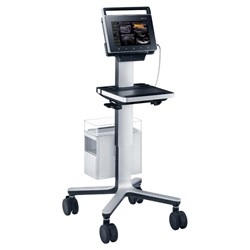Portable, Wireless Ultrasound May Speed EMS Response
By Chuck Seegert, Ph.D.

Samsung has completed a field trial that put its new portable ultrasound system into the hands of first responders. The system includes secure wireless connectivity that allows earlier, more accurate patient evaluation prior to arrival at the hospital.
Emergency medical systems (EMS) have one key requirement — speed. Getting patients to the hospital environment with its specialized equipment and highly trained personnel must happen as quickly as possible to give trauma victims the best possible chance for survival. When they arrive at the hospital, each patient is examined and evaluated for treatment and then specialists may be called in.
The sequence of events that leads to calling a specialist, while relatively rapid (sometimes 30 to 45 minutes), may take time that could be critical to the patient’s survival. Performing evaluations in the EMS vehicle on the way to the hospital is one way Samsung’s new portable ultrasound system can have a positive impact, according to a recent press release from the company.
“Time to the operating theater is critical in determining the survival of trauma patients,” said Dr. Raj Gandhi, Trauma Medical Director, John Peter Smith Hospital, Fort Worth, in the press release. “By receiving ultrasound images from the emergency services personnel while the patient is en route, I can make a more accurate determination if surgery is required and have the patient transported directly to the operating room. This trial points to a significant opportunity to improve our emergency services protocols that has the potential to save many lives.”
The trial was conducted in the Dallas-Fort Worth metropolitan area and was used in 91 callouts for trauma, abdominal pain, internal bleeding, and cardiac arrest, according to the press release. Images and ultrasound data are wirelessly transmitted to doctors using a mobile encryption image management system, allowing real-time collaboration with physician’s at the emergency room.
Key findings summarized from the press release for this phase of the trial include:
- Several cases of internal bleeding were identified early, allowing faster treatment upon arrival at the hospital. This included alerting relevant specialists and ensuring that they were on hand when the patient arrived.
- Use of the system to evaluate several patients with no pulse allowed EMS responders to detect heart movement, which prompted them to continue resuscitation efforts that eventually led to successful discharge of the patient from the hospital.
- Over 50 medics were trained and had access to the tablet-based ultrasound system, which proved capable of transmitting data in as little as 30 seconds.
Advances like this new, portable ultrasound system demonstrate the value of wirelessly connecting different portions of the healthcare system. Ensuring secure communication is also critical, however, and cybercrime is always something to consider. Recently, the FDA released a cybersecurity guidance document to help navigate this important space.
Image Credit: Samsung Medison UGEO PT60A Ultrasound Machine
